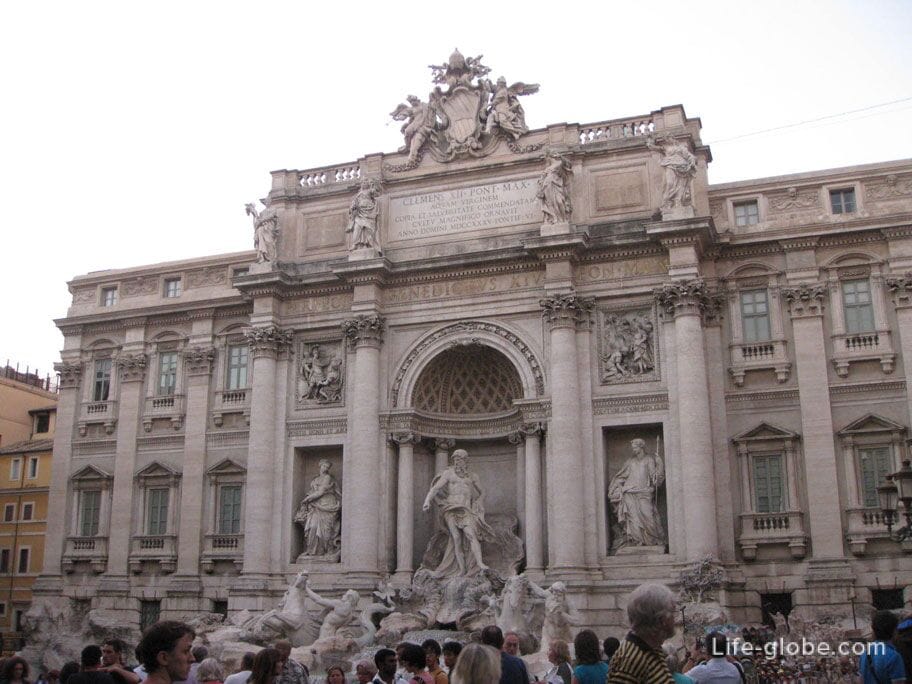
Trevi Fountain (Fontana di Trevi), located in the Italian city of Rome, is considered an architectural gem, the largest and most famous fountain in Rome. Every day near the fountain collects hundreds of tourists. When we were in Rome, the largest gathering of people turned out to be right next to the Trevi Fountain and in Piazza di Spagna. The people tried to take pictures in various poses, however, due to the large concentration of people, the desired photos did not work out, from which each was photographed again and again.
The fountain itself is already fairly impressive size, and because it is adjacent to the facade of the Palazzo Poli, the majestic facade of the Palace and the fountain near it are visually perceived as a single whole, from which creates a stunning effect in a fountain of enormous size. Yes... Architect Nicola Sylvie coped with the task perfectly.
At the foot of the fountain extends the area of Trevi (Piazza di Trevi), 00187 Roma Italy. And through this crowd even as it dissipates. However, this is not particularly helps. The size of the Trevi fountain reaches 26 meters high and 20 meters wide, so the small square of Trevi fountain still too large.
This massive and spectacular attraction is more like not a fountain, and the scene of some of the antique pieces made in stone, rather than a source of clean water. The impression that the water in the fountain is only a small addition, whereby the composition of the sculptures and became known as a fountain.

The Trevi fountain is an architectural decision that is worth seeing by day and by night. The day, of course, to admire the stone statues and to see everything in great detail. And in the evening and at night, when the street is already dark, the fountain is illuminated by many lamps and acquires a completely different, warm shades of colors, thanks to what appears in a completely different form, and the stone sculpture seems like that's about to come to life.
By the way, in history, near the Trevi fountain shot a lot of movies. Among them such famous as "Roman Holiday", "Sweet life", Comedy, "Crazy in Love" and many others all list them here does not make sense.
Around the Trevi fountain go to interesting beliefs, one of which says the man, turning to the fountain back and shoulder throwing a coin in it, will come to Rome again. Well, we all know this, and do it all the time, when somewhere to go. Most of the coins thrown into the sea.
But these beliefs, perhaps, little known. So, if you throw in a fountain, two coins, then you certainly promises a love meeting. But if two coins thrown in love, then they will be a happy marriage.
Throw three coins for the wedding. Four - for wealth, prosperity and success. But the five coins to throw not worth it, or throw is for those who want to get rid of Intrusive human presence, because the five coins lead to separation.
Us coins didn't throw, because just don't believe in these legends and beliefs. True, these beliefs or not, we don't know, but if you believe in it - so true, and you will surely come.
All these marketing moves to generate good revenue. The average amount of money which is annually "harvested" from the fountain up to 700 000 Euro. And it's not as many, 58 333 thousand euros per month. They say that all the money obtained from the fountain, go to donations, I hope it's true.
The whole composition of the Trevi fountain is fully devoted to the sea.
From the center of the fountain, standing on a huge shell, like a chariot, leaves the mythical God of the Ocean (some sources Neptune), with a beautiful muscular figure of Hercules. God of the Ocean majestically held out his right hand, as if controlling the water cascades fountain and commanding all waters of the earth. The sink pull the tritons and hippocampi (sea horses), which in the ensemble of the fountain located just below the Ocean.
In the niches on either side of Neptune are placed allegorical figures, and above them are the bas - reliefs. On the right a bas-relief statue of a young girl. This sculpture, virgin girls, once pointed out to the Roman soldiers, where is the source of life-giving water, so necessary in the hot Italian climate. Later it is from this source was laid aqueduct (water conduit) through which water was supplied to Rome. From which the aqueduct as the source, called Acqua Vergine. Acqua Vergine literally translates as, acqua - water, vergine - virgin, which means the pristine water, that is, the original pure water.


Due to the fact that the composition of the fountain made of stone and water cascades flows down the niches of the stones, gurgling streams of water noisily falling down, fall on the stones, thereby creating a sound similar to the sound of the waves lapping on the shore rocks. This sound is carried a long distance from the Trevi fountain. Even without seeing the fountain, we sound determined where you want to go.
Fountain fountain, beauty beauty and Bal blah blah. You can talk for a long time. But personally we liked the area of Rome, especially Piazza del Popolo.